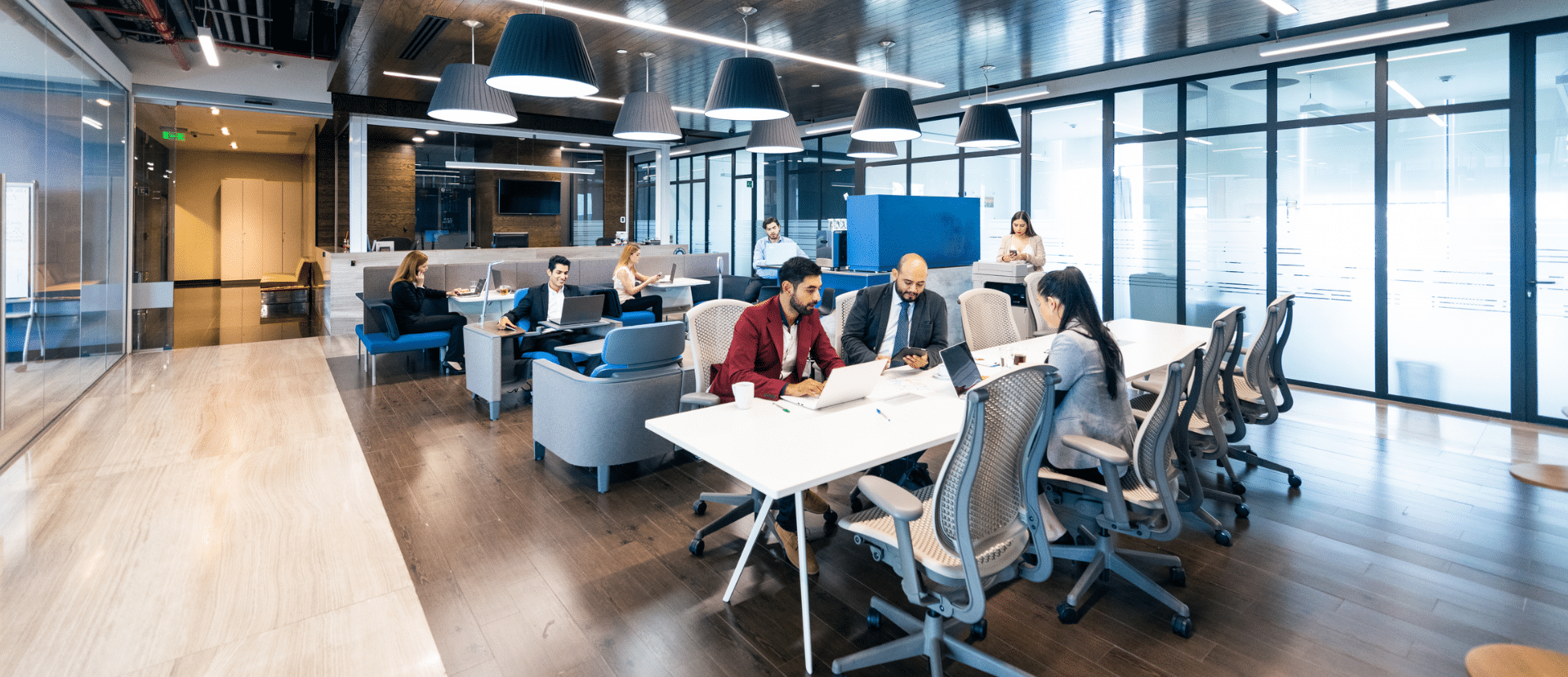In the evolution of the corporate landscape, how we utilize and manage our workspaces is undergoing a fundamental transformation. Data is king, and nowhere is this truer than in the realm of workplace optimization. Occupancy metrics—once ignored entirely—are now taking center stage in boardrooms and executive meetings.
Surviving the COVID-19 pandemic has given us all a new perspective on life. The general workforce is making it abundantly clear they do not want to be cooped up in a standard office from 9-5 every day of the week. Businesses are finding they need to either adapt their working environment to this new wave of workers or face the consequences.
In this blog, we’ll discuss how occupancy metrics are changing how business owners and CEOs make decisions, why data-driven information is king, how occupancy metrics can be used in decision-making, and what the future holds for space planning in the corporate setting.
What are Occupancy Metrics?
Occupancy metrics are a collection of data points that reveal how spaces within a workplace are being used. These metrics encompass a wide range of insights, including:
- Space Utilization Rate: The percentage of available space actually used over a defined period.
- Peak Occupancy: The highest number of people occupying a space at a given time.
- Occupancy Density: The average number of people per square foot in a space.
- Space Occupancy Patterns: How different spaces (conference rooms, desks, etc.) are used throughout the day or week.
These metrics are key to getting a granular, data-backed understanding of your occupancy rates and how your staff navigates your office space.

Gut Feeling vs. Data-Driven Decision-Making
Historically, workspace configuration, design, and allocation decisions were often based on gut feelings and anecdotal observations. You can probably picture it now: a grotesque amount of bulky, unused cubicles splayed out in the middle of an office building with side rooms used for meetings once in a blue moon. This approach inevitably leads to inefficiencies: underutilized conference rooms sit empty while employees hunt for desks, or entire floors sit vacant for days because all your employees are in a hybrid work model.
Occupancy metrics empower companies to shift away from subjective decision-making and embrace a data-driven approach. Objective, quantifiable data provides a clear, unbiased picture of how your workspace is actually being used, not just how you think it’s being used.
Companies like OfficeSpace Software are taking this idea a step further with their real-time space utilization data. Get insight on when people are clocking into the office, what conference rooms are used most, where there is underutilized space, and more.
Those who want to practice effective space management in their office must embrace a more data-driven approach to their design.
Why are Occupancy Metrics Used in Corporate Decision-Making?
The rise of occupancy metrics in corporate decision-making isn’t a fad, it’s a direct response to the very real benefits they offer, and the way hybrid work models are revolutionizing how we use offices. As worker preferences change, so must the companies they work for. Below are some of the main reasons business owners are using occupancy metrics to inform their decisions.
- The Rise of Hybrid Work: The shift towards hybrid working models has fundamentally transformed the purpose of the office. It’s no longer merely a place to do individual work, but a hub for collaboration, connection, and activities that can’t easily be done remotely. Occupancy metrics are essential to tailor office design to this new reality, ensuring spaces are designed to maximize the benefits of in-person interactions.
- Cost Reduction: Optimizing space utilization can lead to significant cost savings. Think of every unused desk or meeting room as money left on the table. With hybrid work, employees may be in the office only a few days a week, making dedicated desks even less cost-efficient. By making sure underutilized areas are either being transformed into more effective workspaces or eliminated entirely, businesses can optimize offices and save on unnecessary corporate real estate costs.
- Improved Employee Experience: Occupancy metrics help identify bottlenecks, underused spaces, and misalignment between workspace types and how teams actually collaborate. For example, a predominantly hybrid workforce might benefit from more collaborative zones and fewer individual workspaces.
- Enhanced Sustainability: Efficiently used workplaces minimize energy consumption and reduce the company’s overall environmental footprint. Hybrid work naturally results in decreased office occupancy, which should result in decreased energy use.
- Agility and Adaptability: Tracking space usage patterns over time empowers companies to respond quickly to changes in work styles or business needs. The hybrid format is still evolving – occupancy metrics offer the flexibility to adjust your office alongside these shifts.
Occupancy Metrics in the Workplace
We’ve highlighted the key reasons businesses are interested in occupancy trends. This type of data provides actionable insights that facility managers can use to cut costs and improve employee happiness. Let’s delve deeper into the specific impacts this data can have on real estate investments, space optimization, and portfolio planning.
- Right-Sizing Your Real Estate: Do you have too much space or not enough? Occupancy metrics provide the hard evidence needed to make informed decisions about leases, expansions, or downsizing.
- Redesigning for Productivity: Pinpoint which spaces promote collaboration and which are consistently empty. Use desk booking software and occupancy sensors to revamp your floor plans for maximum efficiency.
- Justifying Workplace Investments: Demonstrating the ROI of new technologies or workspace initiatives is easier when you have pre- and post-implementation occupancy data to compare.
- Supporting Hybrid Work Models: Understand how often employees are physically in the office, what types of spaces they gravitate to, and how occupancy fluctuates throughout the week.
Clearly, occupancy data can offer more insight than just employee activity within a workplace. When considering expansion or constructing an office space from scratch, this data can help drive your decision.
Challenges in Using Occupancy Metrics
While the advantages of occupancy metrics are undeniable, their implementation isn’t without challenges. Oftentimes facility managers need to revamp their entire office setup to accommodate the installation of data-tracking software. Similarly, teams that have already previously locked themselves into a long-term lease may struggle to move into a different space. Below are common roadblocks facility managers face when implementing occupancy metrics.
Data Collection: Properly deploying sensors, software, and processes to collect accurate occupancy data takes careful planning and execution. This can sometimes mean the construction of a new building, retrofitting a current office space, or moving into a space that already has this technology in place.
Data Privacy: When collecting data, business owners must be conscientious of their team’s privacy and be steadfast about data protection practices.
Change Management: Shifting an organization from a gut-feeling approach to data-driven decision-making requires buy-in and training at all levels. This will not happen overnight. Be transparent about why you are collecting certain data and be open to feedback from employees about the changes you make.
A variety of challenges will surely arise during your shift to a data-driven workplace design and it will take some time to overcome them. For a lot of businesses, this is a complete 180 from how they previously operated. It’s important to be aware of these potential challenges and plan for when they occur.
The Data-Driven Future of Office Spaces
The workplace is evolving, and the businesses that will thrive are those ready to embrace the power of occupancy metrics. These insights are the key to unlocking strategic, cost-effective, and employee-centric office spaces that align with the realities of the modern workforce.
The impact of occupancy metrics isn’t limited to single workplaces. They’re reshaping the entire corporate real estate landscape. Companies are becoming more open to models like hot-desking and activity-based workspaces, relying on occupancy data to ensure space is being allocated efficiently.
The office is no longer just a place to do work—it’s shifting toward more of a social hub, and occupancy metrics can ensure spaces create connection and collaboration.
What Does the Future Hold for Occupancy Metrics?
The integration of occupancy metrics into the corporate world will continue deepening in the near future. AI technology is advancing at an alarming pace, meaning those who fail to adapt to this new wave of decision-making will soon be left obsolete. Here are things we can expect to see in the future:
- AI Integration: AI-powered analytics tools like OfficeSpace Software will analyze data even more effectively, predicting future needs and automating adjustments.
- Sensor Advancements: Smaller, more innovative, and more affordable sensors will expand data collection capabilities.
- Beyond Space: Expect occupancy metrics to influence resource allocation, energy management, and even cleaning schedules.
It’s nearly impossible to predict what the next revolutionary piece of tech will be, but it’s a wise idea to keep an eye on industry trends that may directly impact your workplace.
OfficeSpace Software is Here to Optimize Your Workspace
Guesswork and outdated assumptions have no place in corporate real estate decisions. It’s time to replace them with clear, actionable data. That’s where OfficeSpace Software excels. Our integrated platform collects and analyzes occupancy metrics with unparalleled precision, transforming raw data into insights that drive smarter, more sustainable workspace strategies.
Ready to unleash the full potential of your office space? Discover how OfficeSpace Software can help you create a workplace that truly works for you.





